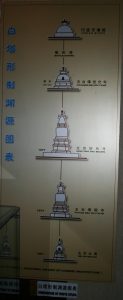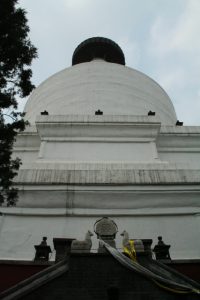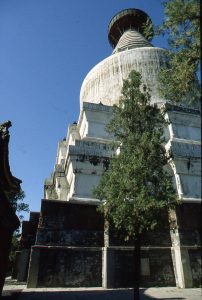Da sheng shou wan an si 大聲壽萬安寺
The Da sheng shou wan an temple (大聲壽萬安寺) was built sometime between 1279 and 1288 in the western part of Beijing by order of Qubilai, and originally housed the renowned Sandalwood Buddha. The sandalwood statue was said to have been the only lifelike portrait of the Buddha, carved during his lifetime in 990 B.C. by his disciple Maudgalyayana. Its presence in Beijing greatly added to the prestige of the Yuan Mongol empire.
The planning of the Da sheng shou wan an si is attributed in his biography to the Nepali architect and sculptor A ni ge (阿尼哥), who came to work at the Yuan court in 1261 and died in 1306. The temple was also known as Baita si (白塔, Temple of the White Stupa), because it was built around the Baita (White Stupa), the oldest and highest stupa or pagoda in Beijing. The 167 foot high stupa was completed in 1279 and long dominated the skyline of the western part of the city.
Just before the Yuan Mongol court fled Beijing for the north, the Da sheng shou wan an si was struck by lightning. This was on June 20, 1368, and except for two halls, the temple burnt to the ground. The Sandalwood Buddha had been moved before this to a temple inside the imperial palace. The White Stupa still stands, although it has been renovated many times during the Yuan, Ming, Qing, and Republican periods. In 1457 a new temple was erected around the stupa and called the Miaoying si (妙應寺, Temple of Miraculous Evidence). Popularly, it was again known as the Baita si.
Sources:
Franke, Herbert. 1978. From tribal chieftain to universal emperor and god: the legitimation of the Yuan dynasty, Sitzungsberichte – Bayerische Akademie der Wissenschaften, Philosophisch-Historische Klasse. Munchen: Verlag der Bayerischen Akademie der Wissenschaften.
Franke, Herbert, 1994, “Consecration of the ‘White Stupa’ in 1279,” Asia Major VII (Third Series) (1): 155-184
Entry by Stacey Van Vleet, 2/4/07





